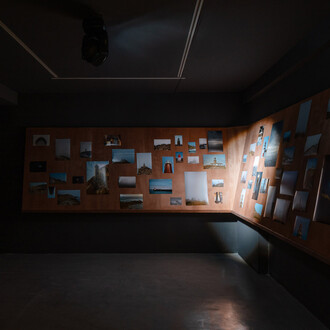Prats Nogueras Blanchard is pleased to present When things fall apart, an exhibition by Joseph Grigely (1956, Massachusetts) and Amy Vogel (1967, Washington, D.C.).
When things fall apart is an exhibition about things going wrong—with our bodies, with our lives, with the world.
Much of the exhibition chronicles the way bodies respond to disruptive change: in Grigely’s case, an eye hemorrhage that occurred in the winter of 2022, which occluded his vision in his right eye. For one month, Grigely made watercolors almost every day, documenting what he could see through his eye: a tangle of rings of light and dark, of specks and blobs and swirls. Initially made as documentation for his retina surgeon, the watercolors now stand apart as an ineffable moment of being, when words could not describe the transformative moments when the body reshaped itself.
For Vogel, the turning point was an autoimmune disease that affected her physical movement, such as walking and drawing. Over the past two decades Vogel has chronicled in her art transformations of the natural world and our relationship with it as a form of ‘undoing’ . In her new erasure drawings nature contends with the dilemma of entropy and change. Permanence—of images and bodies alike—is destabilized.
Grigely and Vogel have been working closely together for more than 25 years, sharing studio and home as well as collabora tive projects. For both artists, their art is not so much ‘about’ disability as it is an embodiment of disability, and ways both our bodies and minds respond to changing physical and mental states. In doing so, their works challenge and reshape traditional perceptions of what disability is, turning what is often seen as disabling into something enabling.
In Amy Vogel’s new erasure drawings nature contends with the dilemma of entropy and change: we are not what we were. For Vogel this is communicated by a smudge or cross-out, an erasure or scrubbed surface or simply negative space, anything that undermines the resolution or stability of an image.
Initially made as documentation for Grigely’s retina surgeon, the watercolors now stand apart as an ineffable moment of being, when words could not describe the transformative moments when the body reshaped itself.
The exhibition includes a new publication by Joseph Grigely, My sick eye drawings, published in an edition of 1500.
Joseph Grigely was born in Massachusetts in 1956. Grigely is an artist and wri ter whose work addresses questions about the materialization of language and communication, as well as the ways in which conversations can be represented in the absence of speech. Deaf since the age of ten, his body of work is the re sult of what he describes as “observing the world with the sound off”, and the process of collecting inscribed words, documents and artifacts created during his conversations with people who do not know sign language. His work attends to the archive and its practices, and how it might be activated with formal and narrative meaning.
Grigely’s recent solo exhibitions include the Massachusetts Museum of Contem porary Art, North Adams (2023), Serralves Foundation, Porto (2021), George town University, Washington. D.C. (2021), and The Serpentine, London (2017). Recent group shows include Kunsthal Nikolaj, Copenhagen (2024), Museum of Contemporary Art, San Diego (2024), Frac Normandie Rouen (2021), Stedelijk Museum, Amsterdam (2021), Bozar, Brussels (2020), and Luma Foundation, Ar les (2020). Grigely’s work is in collections that include the Tate Modern, London; the Stedelijk, Amsterdam; Kunsthaus, Zurich; Smak, Ghent; and both MoMA and the Whitney in New York. His books include Textualterity: art, theory, and textual criticism (1995), Conversation pieces (1998), Exhibition prosthetics (2010), MacLean 705 (2015), Oceans of love: the uncontainable Gregory Battcock (2016), and Acknowledgments (2024). A new book, Otherhow: essays and documents on art and disability, will be published in 2025 by Primary Information, New York.
Amy Vogel was born in Washington, D.C. in 1967. Vogel’s work addresses our hu man relationship with nature—how we attempt to shape and reshape it, and use and abuse it, as part of the process of living as we do—either in urban or rural contexts. In Vogel’s world of nature, there is always something contaminating it, complicating it, mucking it up. The artist “paints” and “sculpts” and “makes,” but these verbs belie the fact that the process involves a repertoire of negating ac tivities—unpainting as much as painting, unsculpting as much as sculpting, and unmaking as a form of making.
Vogel has had solo exhibitions and projects at Paul Kotula Projects, Detroit (2024, 2017, 2008), Air de Paris, Paris (2017, 2005), and Larissa Goldson, New York (2011, 2008). Group exhibitions include Tomorrow, and tomorrow, and tomorrow, Design Museum of Chicago (2022), Women on Paper, Espace de l’Art Concret, Mouans-Sartoux (2018), and The Art of the Lived Experiment, Bluecoat, Liver pool UK (2014). She and Joseph Grigely have collaborated for over twenty years on a number of films, sculptures and audio installations that have been shown at Massachusetts Museum of Contemporary Art, North Adams (2023), Mu.Zee, Ostend, Belgium (2014), Albright-Knox Art Gallery, Buffalo (2009), Douglas Hyde Gallery, Trinity College, Dublin (2009), and the Museum of Contemporary Art, Chicago 2008), Western Front Exhibitions, Vancouver (2006) and Institute Ma thildenhöfe, Darmstadt (2006).
















